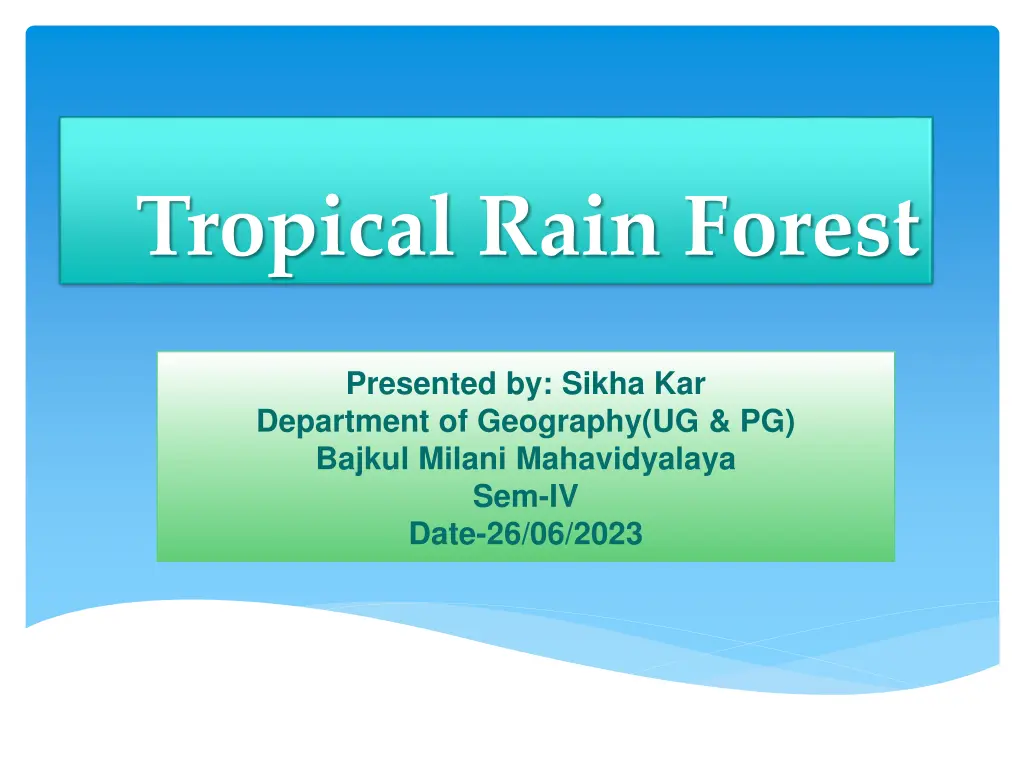
Exploring the Wonders of Tropical Rainforests
Dive into the enchanting world of tropical rainforests, where dense canopies, diverse plant and animal life, and unique adaptations thrive under a humid climate. Discover the structure, distribution, climate, and adaptations of these vital ecosystems. Uncover the beauty and threats facing these precious forests today.
Download Presentation

Please find below an Image/Link to download the presentation.
The content on the website is provided AS IS for your information and personal use only. It may not be sold, licensed, or shared on other websites without obtaining consent from the author. If you encounter any issues during the download, it is possible that the publisher has removed the file from their server.
You are allowed to download the files provided on this website for personal or commercial use, subject to the condition that they are used lawfully. All files are the property of their respective owners.
The content on the website is provided AS IS for your information and personal use only. It may not be sold, licensed, or shared on other websites without obtaining consent from the author.
E N D
Presentation Transcript
Tropical Rain Forest Presented by: Sikha Kar Department of Geography(UG & PG) Bajkul Milani Mahavidyalaya Sem-IV Date-26/06/2023
Tropical Rainforests Introduction Distribution of Rainforest Climate Structure of the Forest Plant adaptations Animal adaptations Threats to the forest Conclusion
Introduction Tropical rainforests, which worldwide make up one of Earth's largest biomes (major life zones), are dominated by broad-leaved trees that form a dense upper canopy (layer of foliage) and contain a diverse array of vegetation and other life.
Climate Climate The temperature averages 28- 30 C all year but gets warmer in March and September when the sun is not directly overhead and there is less cloud. There is a convectional storm almost every afternoon except in March and September when, because there is less sunshine, there is less evaporation so the atmosphere is not so full of moisture and there are fewer clouds. The climate is described as humid
Structure of the Forest 1. 2. 3. 4. Shrub layer Emergents Canopy Under canopy
Plant adaptations Emergents and the Canopy Plants have waxy leaves and drip tips to allow heavy rainfall to run off. The canopy and the emergents have buttress roots, to anchor the tree. Large leaves and dark green foliage to maximise photosynthesis. These emergent trees grow to over 40m as they try to gather the maximum amount of sunlight. The canopy forms a closed layer which allows little light through. There is a huge amount of growth in all layers every year. The increase in the Biomass is balanced by the amount of decay. This is Nutrient cycling. This can be shown in a Gersmehl Diagram.
The under canopy In this layer plants have to be shade tolerant; they have very big and very dark green leaves. There are often few branches on the tall, straight trunks. Flowers are very bright to attract insects; the air is too still for wind pollination. There are sometimes parasitic plants living on the trunks of trees: they get their food from the host tree. Many of the plants have valuable fruits such as Brazil nuts, bananas, mangoes, rubber
The shrub layer In this layer the shrubs are bushy and have many stems Shrubs have dark green leaves at the top of the plant The plants are shade tolerant They often have bright flowers which are strongly scented Tea, coffee and cocoa are crops that grow naturally in this layer
Ground Layer It is very dark on the forest floor Ferns and orchids are common plants at this level. Some of the plants are parasitic. There are many gaps between plants but it is very difficult to get around due to the tangle of vines and dead, fallen branches. The Litter layer is quite thick but Plant and animal material decays quickly in the hot, humid conditions. This is the Litter layer.
Threats to the forest An area of forest the size of Belgium is clear felled for timber every year Local people have growing populations and need farmland Timber from the tall, straight trees is much sought after for building and for furniture Big business wants to extract resources from under the forest Hydro-electric schemes flood the forest Accidental fires burn out of control
Animal adaptations Rainforests are tremendously rich in animal life. Rainforests are populated with insects (like butterflies and beetles), arachnids (like spiders and ticks), worms, reptiles (like snakes and lizards), amphibians (like frogs and toads), birds (like parrots and toucans) and mammals (like sloths and jaguars). Different animals live in different strata of the rainforest. For example, birds live in the canopy (upper leaves of the trees) and in the emergents (the tops of the tallest trees). Large animals (like jaguars) generally live on the forest floor, but others (like howler monkeys and sloths) are arboreal (living in trees). Insects are found almost everywhere. Many species of rainforest animals are endangered and many other have gone extinct as the number of acres of rainforests on Earth decreases.
Conclusion Tropical rainforests are important resources that could not be replaced. By destroying the tropical rainforests, we are destroying the ecosystem and environment, which in turn threaten the human species ourselves.










